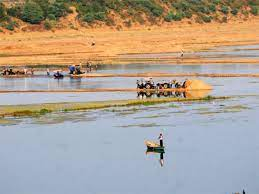CURRENT AFFAIRS
Get the most updated and recent current affair content on Padhaikaro.com
Tapi-Par-Narmada Link Project
- Vaid's ICS, Lucknow
- 24, Mar 2022

Why in News?
- Recently, Tribals protested against the Centre’s Tapi-Par-Narmada link Project.
Tapi-Par-Narmada Link Project
- It was envisioned under the 1980 National Perspective Plan under the former Union Ministry of Irrigation and the Central Water Commission (CWC).
- It is one of the 16 link proposals under the Peninsular Rivers Development Component.
It proposes to link three rivers:
- Par: Originating from Nashik in Maharashtra and flowing through Valsad.
- Tapi: From Saputara that flows through Maharashtra and Surat in Gujarat.
- Narmada: Originating in Madhya Pradesh and flowing through Maharashtra and Bharuch and Narmada districts in Gujarat.
- The project proposes to transfer water from the water surplus regions of Western Ghats to the water deficit regions of Saurashtra and Kutch.
Issues and Concerns
Displacement of Tribals:
- Tribals are opposing the project because they will lose their land leading to their displacement.
- In case of displacement, they will have to work from scratch to make that barren land into a cultivable one.
Income loss:
- With the construction of the reservoirs, tribals’ farmland will be submerged and they will lose their income.
Federal Challenges:
-
- Even if tribal problems are resolved and the project is completed, there still will be issues among the states for water sharing and other benefits arising from the Project.
Affecting Biodiversity:
- The ecology of every river is unique, and let the waters of two rivers mix may affect biodiversity.
Impact of Climate Change:
- Rainfall patterns are changing due to climate change, so the basins now supposed to be surplus might cease to be so in a few years.
Significance of the Project
Irrigation Facilities:
- Providing irrigation benefits to the enroute command and Narmada command.
- This would save Sardar Sarovar water which will be used to extend irrigation in Saurashtra and Kutch region.
Generation of Energy:
- The estimated annual energy to be generated from these powerhouses is of the order of 93 Mkwh.
- The annual benefits from power generation are estimated to be Rs.5,523 lakhs.
Flood Relief/ Disaster Mitigation:
- The reservoirs will provide flood relief to the people residing in downstream areas.
Origin and initiatives of river-linking in India
Background:
- The idea of interlinking of rivers in the Indian subcontinent is at least 150 years old.
- During the British Raj in India, Sir Arthur Cotton, a British general and irrigation engineer, first suggested linking the Ganga and the Cauvery for navigational purposes.
In the 1970s, the idea of transferring surplus water from a river to a water-deficit area was proposed by the then Union Irrigation Minister (earlier the Jal Shakti Ministry was known as the Ministry of Irrigation).
Facts for Prelims :
Narasinghapettai Nagaswaram Bags GI Tag
Nagaswaram made in Narasinghapettai in Thanjavur district has been granted the Geographical Indication (GI) tag on the application filed by the Thanjavur Musical Instruments Workers Co-operative Cottage Industrial Society Ltd.
- This will help the artisans receive assistance from the Indian government and other benefits.
- The GI tag will boost trade.
About Narasinghapettai Nagaswaram
- The artisans based at Narasinganpettai village inherited the skill of making these wooden instruments from their forefathers.
- The nagaswaram now being used by artists throughout is called ‘pari nagaswaram’, which is longer than the ‘thimiri’.
- A major portion of the ‘Narasinghapettai nagaswaram’ is made from the aacha (Hardwickia binata) tree and many a time the artisans use the wood from parts of old houses.
- The front portion — ‘anusu’ or enhancer — is made of ‘vaagai’ wood.
‘Seevali’, the reed, is made from a type of grass that grows on the banks of the Cauvery and the Kollidam.